Management Aptitude Tests
Organizations are putting more time and money into the recruitment process than ever before. The personnel industry press quotes a typical cost of $10,000 to recruit a management-level candidate. Some of this can be accounted for by the cost of advertising the role, but the majority is made up of specifying the role and then selecting the best possible candidate to fill it.
From the perspective of an organization this has meant the introduction of various tests and exercises to ensure that they learn as much about the individual as possible to ensure the best fit with the role.
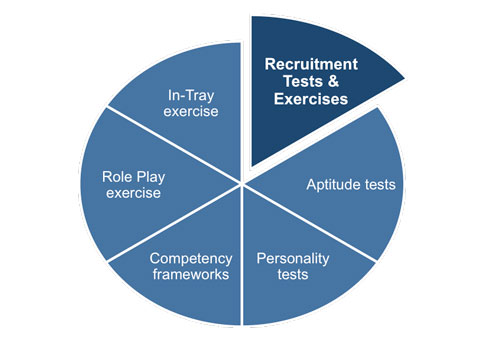 |
The chart above shows you some of the most popular tests and exercises used when assessing potential management candidates. Traditional format interviews where you talk about your competencies and achievements are increasingly complemented by tests and exercises where you are required to show what you do rather than just talk about it.
Some selection exercises like in-tray and role play are designed to mimic certain aspects of the job you will be expected to do. Others, such as personality tests and aptitude tests, seem rather more arbitrary. However, employers have good reasons to use both. Personality tests are dealt with in detail in the 'Preparing for Management Personality Tests' eBook available from the Career Skills area of our website.
Our Management Aptitude Tests eBook is designed to help you prepare for aptitude tests, which are used to test your logical reasoning and thinking abilities. These tests are made up of between 30-50 multiple-choice questions and are strictly timed. Whether taken online or in an office it is vital that you give them 100% of your concentration.
Prepare for them as you would any exam and you will gain the high score you need to stand out from the crowd. Practice and familiarity with the type of questions asked in each kind of test is extremely important because it will save you wasting valuable time working out what the question is asking rather than working out the answer.
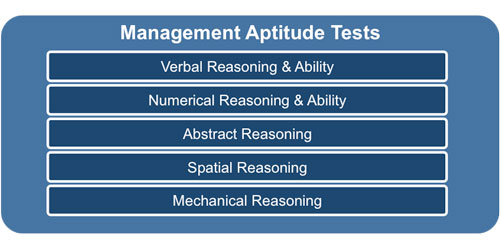 |
The most commonly used aptitude tests are:
Verbal Reasoning and Ability - this test assesses your level of grammar and spelling capability, as well as your ability to understand analogies and follow detailed written instructions.
Numerical Reasoning and Ability - looks at how good your basic mathematical skills are including number sequences. It also gauges your reasoning skills of more complex numerical questions and how well you interpret quantitative information.
Abstract Reasoning Tests - assess your ability to identify the logic of a pattern to determine the next in the sequence or the missing item. These tests determine your logical thinking skills.
Spatial Ability Tests - are designed to evaluate your ability to manipulate two-dimensional shapes. They also assess your capacity to visualize two-dimensional pictures as three-dimensional objects.
Mechanical Aptitude Tests - these tests are very specific to technical roles and are not included in general management tests as they assess an individual's knowledge of physical and mechanical principles.
 |
Aptitude tests frequently have more questions than most people can be easily answer in the time allocated and the complexity of the questions may also increase as you work through the test. They are designed to see what you can achieve when maximizing your efforts and take two forms as shown in the diagram above.
Speed tests - focus on how many questions you can answer correctly in the time allowed. For example:
Question: 139 + 235 =
A) 372 B) 374 C) 376 D) 437
Power tests - focus on your ability to identify the 'best' strategy for answering the question and obtain the correct answer.
For example, you will be presented with a table of sales figures to use to answer the questions:
 |
Practice tests will enable you to become familiar with these types of tests and attain the best score possible.
Employers use your test scores to gauge how well your competencies and capabilities match those required by the role. Knowing how these scores are interpreted helps you appreciate how important improving your score is to be selected to continue in the recruitment process.
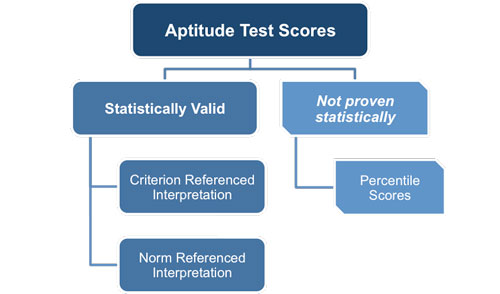 |
There are two statistically proven methods - criterion-referenced interpretation and norm-referenced interpretation and a third method - percentile scores - that is not statistically valid but used by organizations when proficiency standards and norms are not available.
Criterion-Referenced Interpretation - in tests using this method your score reflects your level of knowledge or skill in the test area. It does not compare your score to those attained by others. The organization or test publishers set a score to reflect a minimum level of competency required for a role that is then converted into proficiency standards.
Norm-Referenced Interpretation - this method compares an individual's scores with that of a norm reference group. This norm group is made up from a large representative sample of people. It is their score average and distribution that become the test norms.
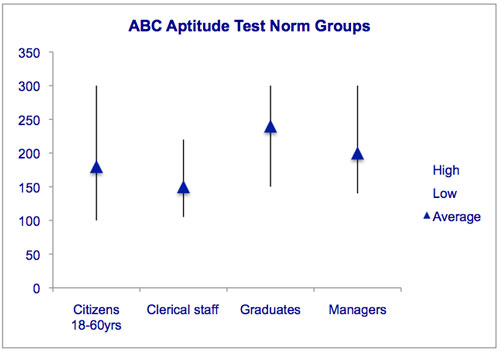 |
The chart shows the wide variation between groups' abilities and qualities, whilst emphasizing the importance of the norm group you will be compared to. A norm group will be selected that best matches the educational and cultural backgrounds including other characteristics of the test group.
Percentile Scores - are not statistically valid as they simply compare your score with that of the other candidates. This method is used when no appropriate proficiency standards are available. As they are easy to understand this type of score is commonly used when candidates are being compared to one another.
To calculate a percentile score an individual's raw score is represented as a percentage of the group who scored below them. For example, if your raw score is higher than 60% of the group your score is in the 60th percentile.
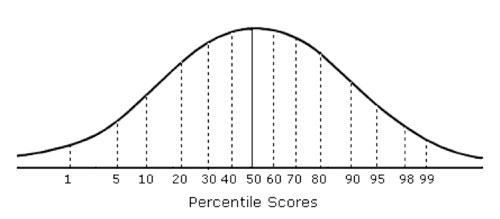 |
This method tends to exaggerate differences close to the mean and minimize those at the extremities. What this means for someone taking tests scored in this way is that each extra point you can add to your score will have a significant impact on your percentile score.
For example, imagine that a group of graduates with similar backgrounds score between 35 and 45 out of 50 questions, and the mean score is 40. In this scenario a score of 40 is in the 50th percentile whereas a score of 45 is in the 90th percentile. In other words, five extra marks would take you from being 'average' to being 'outstanding'.
This illustrates one of the problems of using percentile scores with such a small and homogenous group, and an experienced statistician would realize that ranking candidates in this group by percentile was inappropriate and misleading. However, percentile scores are often used this way, which is why it is so important to get every mark you can in these types of test.
You may also be interested in:
Management Aptitude Tests | Verbal Ability and Reasoning Tests | Numerical Ability and Reasoning Tests | Abstract Reasoning Tests | Spatial Ability Tests | Scoring and Ranking Results.


